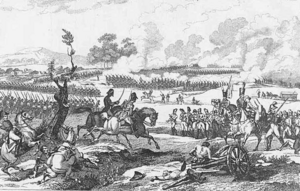Battle of Pozzolo facts for kids
Quick facts for kids Battle of Pozzolo |
|||||||
|---|---|---|---|---|---|---|---|
| Part of the Italian campaigns in the War of the Second Coalition | |||||||
 1836 print depicting part of the battle |
|||||||
|
|||||||
| Belligerents | |||||||
| Commanders and leaders | |||||||
| Strength | |||||||
| 66,000–70,000 men 160 guns |
50,000 men 100 guns |
||||||
| Casualties and losses | |||||||
| 4,000 men | 7,000–9,141 men 29–40 guns |
||||||
The Battle of Pozzolo, also called the Battle of the Mincio River, took place on December 25–26, 1800. It was a major fight during the War of the Second Coalition. A French army, led by General Guillaume Brune, crossed the Mincio River. They defeated an Austrian army under General Heinrich von Bellegarde. This victory pushed the Austrians back. It led to a truce called the Armistice of Treviso, which then led to the Treaty of Lunéville. This treaty meant Austria left the war.
Contents
Why the Battle Happened
General Bellegarde had gathered about 50,000 Austrian soldiers near the Mincio River. He planned to cross it and attack the French. But he heard that the Austrians had lost a big battle in Germany. This was the Battle of Hohenlinden on December 3, 1800. So, Bellegarde decided to wait.
General Brune, commanding about 70,000 French soldiers, saw his chance. He decided to attack first. His plan was to pretend to attack Pozzolo. Meanwhile, his main force would cross the river at a different spot, near Monzambano.
The Battle Begins
On Christmas Day, 1800, French soldiers under General Pierre Dupont de l'Étang began crossing the Mincio River. They crossed near Pozzolo, facing heavy Austrian cannon fire. This was a trick, or "feint," to make the Austrians think the main attack was there.
While this was happening, the French quickly built a temporary bridge nearby. This new bridge was at a place called Molino della Bolta. Dupont moved two divisions of soldiers and 25 cannons across this new bridge. They quickly set up defenses on the other side.
Fighting for Pozzolo
The French received more soldiers from General Louis-Gabriel Suchet. They then defeated an Austrian counterattack that happened around midday. The French successfully captured the village of Pozzolo.
But the Austrians didn't give up. At 1:00 pm, they launched a second attack. This attack included Hungarian troops led by General Konrad Valentin von Kaim. They managed to take Pozzolo back and pushed the French soldiers towards their bridge. However, strong French cannon fire stopped the Austrians from advancing further. The French then attacked again and recaptured the village. They also took five cannons and captured 700 to 800 Austrian soldiers.
General Suchet then built a second bridge. This allowed a whole French division to cross the river without any trouble. The fighting for Pozzolo was very fierce. The village changed hands three more times that day. Finally, a last French attack secured it just before nightfall. During this intense fighting, General Kaim was badly wounded and later died. That night, under a clear moon, the Austrians tried to surprise the French soldiers in their camps.
The Next Day
On December 26, starting at 5:00 am, French troops built another bridge. This one was at Monzambano. A thick fog helped hide them, and 40 French cannons provided cover fire. After crossing, they attacked the Monte Bianco hills. About 35,000 Austrian soldiers were defending these hills.
The French pushed the Austrians back towards Salionze. A French force, led by General Antoine Guillaume Delmas, captured Valeggio sul Mincio. Later that day, the Austrians briefly retook the village. But Delmas and his troops finally secured it for good. The French strengthened their positions in the afternoon. They successfully defended against an Austrian counterattack in the hills.
The Austrians lost about 7,000 soldiers and 40 cannons in the battle. Some reports say the French lost about 4,000 soldiers. Austrian losses included 807 killed, 4,067 wounded, and 3,984 captured. General Kaim was killed, and General Charles Alain Gabriel de Rohan was wounded. The French captured many Austrian cannons, including 14 small cannons and six larger ones.
What Happened Next
General Bellegarde pulled his Austrian forces back during the night of December 26–27. He moved them beyond the Adige river. General Brune and the French army carefully followed the retreating Austrians. Brune paused at the river to wait for his teams that built floating bridges.
Bellegarde moved his troops even further back. He hoped to meet up with some reinforcements. This allowed the French to cross the Adige river without any fighting. After a few smaller battles, the French reached Treviso. There, an armistice (a temporary stop to fighting) was signed on January 16, 1801. This truce became permanent with the Treaty of Lunéville on February 9, 1801. This treaty officially ended Austria's part in the war.
Images for kids


